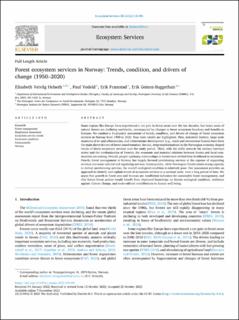| dc.contributor.author | Helseth, Elisabeth Veivåg | |
| dc.contributor.author | Vedeld, P. | |
| dc.contributor.author | Framstad, Erik | |
| dc.contributor.author | Gomez-Baggethun, Erik | |
| dc.date.accessioned | 2022-11-17T14:16:37Z | |
| dc.date.available | 2022-11-17T14:16:37Z | |
| dc.date.created | 2022-11-10T13:09:23Z | |
| dc.date.issued | 2022 | |
| dc.identifier.issn | 2212-0416 | |
| dc.identifier.uri | https://hdl.handle.net/11250/3032505 | |
| dc.description.abstract | Some regions like Europe have experienced a net gain in forest areas over the last decades, but intact areas of natural forests are declining worldwide, accompanied by changes in forest ecosystem functions and benefits to humans. We conduct a biophysical assessment of trends, condition, and drivers of change of forest ecosystem services in Norway from 1950 to 2020. Four main results are highlighted. First, industrial forestry, large scale measures of re- and afforestation, and infrastructure development (e.g., roads and recreational homes) have been the main direct drivers of forest transformation. Second, deep transformations in the Norwegian economy shaped trends of forest ecosystem services over the study period. Third, with the shifts towards the tertiary (service) sector and the mechanization of forestry, the economic and material relations between forests and local communities are waning. Overall, people’s primary relationships to forests have shifted from livelihood to recreation. Fourth, forest management in Norway has largely favored provisioning services at the expense of supporting services and some cultural and regulating services. Consequently, while Norwegian forests retain strong capacity to deliver provisioning services, the overall ecological condition is relatively poor. Our assessment provides an approach to identify and explain trends of ecosystem services at a national scale, over a long period of time. We argue that growth in forest area and biomass are insufficient indicators for sustainable forest management, and that future forest polices would benefit from improved knowledge on forests ecological condition, resilience against climate change, and socio-cultural contributions to human well-being. Forest management Biophysical assessment Ecosystem service trends Ecosystem condition Fennoscandia Norway | |
| dc.language.iso | eng | |
| dc.title | Forest ecosystem services in Norway: Trends, condition, and drivers of change (1950–2020) | |
| dc.title.alternative | Forest ecosystem services in Norway: Trends, condition, and drivers of change (1950–2020) | |
| dc.type | Peer reviewed | |
| dc.type | Journal article | |
| dc.description.version | publishedVersion | |
| dc.subject.nsi | VDP::Samfunnsøkonomi: 212 | |
| dc.subject.nsi | VDP::Economics: 212 | |
| dc.subject.nsi | VDP::Samfunnsøkonomi: 212 | |
| dc.subject.nsi | VDP::Economics: 212 | |
| dc.source.volume | 58 | |
| dc.source.journal | Ecosystem Services | |
| dc.identifier.doi | 10.1016/j.ecoser.2022.101491 | |
| dc.identifier.cristin | 2071845 | |
| dc.relation.project | Norges forskningsråd: 300498 | |
| dc.relation.project | Egen institusjon: NMBU’s Sustainability Arena ‘Embedding Planetary boundaries | |
| dc.relation.project | Norges forskningsråd: 295191 | |
| cristin.ispublished | true | |
| cristin.fulltext | original | |
| cristin.qualitycode | 1 | |
